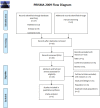Association of small intestinal bacterial overgrowth with nonalcoholic fatty liver disease in children: A meta-analysis
- PMID: 34855819
- PMCID: PMC8638857
- DOI: 10.1371/journal.pone.0260479
Association of small intestinal bacterial overgrowth with nonalcoholic fatty liver disease in children: A meta-analysis
Abstract
It has been suggested that small intestinal bacterial overgrowth (SIBO) could cause nonalcoholic fatty liver disease (NAFLD), but this association was not examined in children by meta-analysis. This meta-analysis aimed to determine the association between SIBO and NAFLD in children. The electronic databases PubMed, Embase, and Cochrane Library were searched for studies published before April 22, 2021. The outcome was the association between SIBO and NAFLD. Three studies and 205 children were included. All three studies reported the association between SIBO and NAFLD. Children with SIBO were more likely to have NAFLD (odds ratio = 5.27, 95% confidence interval (CI): 1.66-16.68, P<0.001; I2 = 63.5%, Pheterogeneity = 0.065). When directly pooling the reported relative risks (RR) from two studies, children with NAFLD had an over 2-fold increased relative risk of developing SIBO (RR = 2.17, 05%CI: 1.66-2.82, P<0.001; I2 = 0.0%, Pheterogeneity = 0.837). This meta-analysis reports a possible association between SIBO and NAFLD in children.
Conflict of interest statement
The authors have declared that no competing interests exist.
Figures
Similar articles
-
The relationship between non-alcoholic fatty liver disease and small intestinal bacterial overgrowth among overweight and obese children and adolescents.J Pediatr Endocrinol Metab. 2017 Oct 26;30(11):1161-1168. doi: 10.1515/jpem-2017-0252. J Pediatr Endocrinol Metab. 2017. PMID: 28988228
-
The role of Small Intestinal Bacterial Overgrowth (SIBO) in Non-alcoholic Fatty Liver Disease (NAFLD) patients evaluated using Controlled Attenuation Parameter (CAP) Transient Elastography (TE): a tertiary referral center experience.BMC Gastroenterol. 2019 Mar 20;19(1):43. doi: 10.1186/s12876-019-0960-x. BMC Gastroenterol. 2019. PMID: 30894137 Free PMC article.
-
Small Intestinal Bacterial Overgrowth Is Associated with Non-Alcoholic Fatty Liver Disease.J Gastrointestin Liver Dis. 2016 Jun;25(2):159-65. doi: 10.15403/jgld.2014.1121.252.iwg. J Gastrointestin Liver Dis. 2016. PMID: 27308646
-
Small intestinal bacterial overgrowth and nonalcoholic fatty liver disease: a systematic review and meta-analysis.Eur J Gastroenterol Hepatol. 2020 May;32(5):601-608. doi: 10.1097/MEG.0000000000001541. Eur J Gastroenterol Hepatol. 2020. PMID: 31567712
-
The role of intestinal bacteria overgrowth in obesity-related nonalcoholic fatty liver disease.Nutrients. 2014 Dec 3;6(12):5583-99. doi: 10.3390/nu6125583. Nutrients. 2014. PMID: 25479248 Free PMC article. Review.
Cited by
-
Small intestinal bacterial overgrowth in chronic liver disease: an updated systematic review and meta-analysis of case-control studies.EClinicalMedicine. 2024 Dec 31;80:103024. doi: 10.1016/j.eclinm.2024.103024. eCollection 2025 Feb. EClinicalMedicine. 2024. PMID: 39844931 Free PMC article.
-
Small Intestinal Bacterial Overgrowth (SIBO) and Twelve Groups of Related Diseases-Current State of Knowledge.Biomedicines. 2024 May 7;12(5):1030. doi: 10.3390/biomedicines12051030. Biomedicines. 2024. PMID: 38790992 Free PMC article. Review.
-
Web of Science-Based Visualization of Metabolic Dysfunction-Associated Fatty Liver Disease in Pediatric and Adolescent Populations: A Bibliometric Study.Health Sci Rep. 2025 Jan 29;8(2):e70409. doi: 10.1002/hsr2.70409. eCollection 2025 Feb. Health Sci Rep. 2025. PMID: 39897463 Free PMC article.
-
Microbial-derived metabolites as a risk factor of age-related cognitive decline and dementia.Mol Neurodegener. 2022 Jun 17;17(1):43. doi: 10.1186/s13024-022-00548-6. Mol Neurodegener. 2022. PMID: 35715821 Free PMC article. Review.
-
Epidemiology of small intestinal bacterial overgrowth.World J Gastroenterol. 2023 Jun 14;29(22):3400-3421. doi: 10.3748/wjg.v29.i22.3400. World J Gastroenterol. 2023. PMID: 37389240 Free PMC article. Review.
References
-
- Chalasani N, Younossi Z, Lavine JE, Diehl AM, Brunt EM, Cusi K, et al.. The diagnosis and management of non-alcoholic fatty liver disease: practice guideline by the American Gastroenterological Association, American Association for the Study of Liver Diseases, and American College of Gastroenterology. Gastroenterology. 2012;142(7):1592–609. doi: 10.1053/j.gastro.2012.04.001 . - DOI - PubMed
-
- Collaboration NCDRF. Worldwide trends in body-mass index, underweight, overweight, and obesity from 1975 to 2016: a pooled analysis of 2416 population-based measurement studies in 128.9 million children, adolescents, and adults. Lancet. 2017;390(10113):2627–42. doi: 10.1016/S0140-6736(17)32129-3 ; PubMed Central PMCID: PMC5735219. - DOI - PMC - PubMed
-
- Anderson EL, Howe LD, Jones HE, Higgins JP, Lawlor DA, Fraser A. The Prevalence of Non-Alcoholic Fatty Liver Disease in Children and Adolescents: A Systematic Review and Meta-Analysis. PloS one. 2015;10(10):e0140908. doi: 10.1371/journal.pone.0140908 ; PubMed Central PMCID: PMC4626023. - DOI - PMC - PubMed
Publication types
MeSH terms
LinkOut - more resources
Full Text Sources
Medical
Miscellaneous





